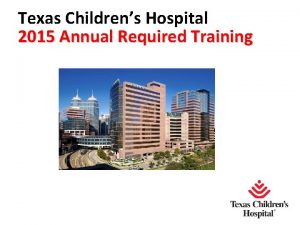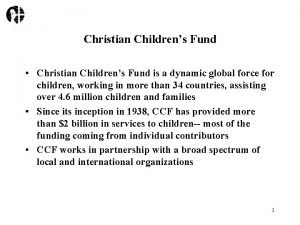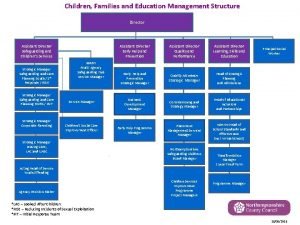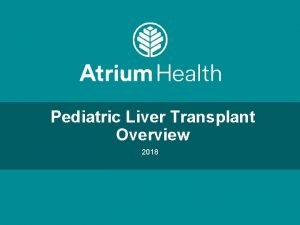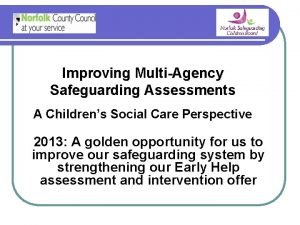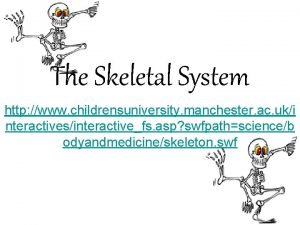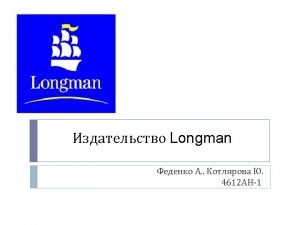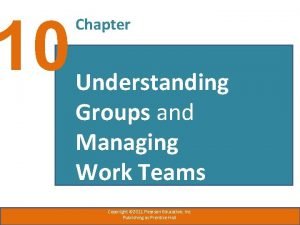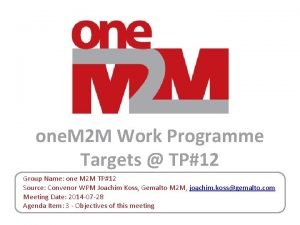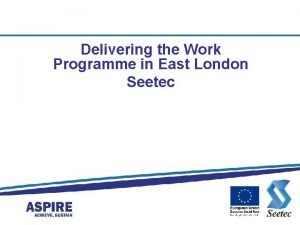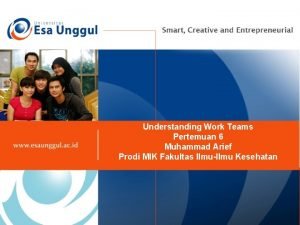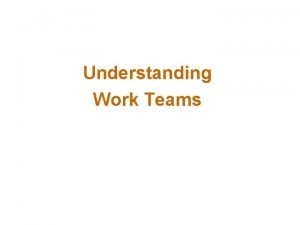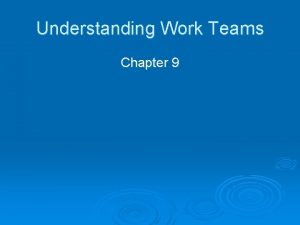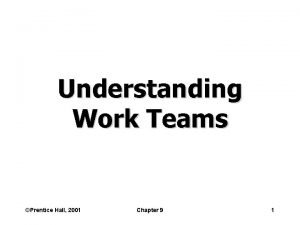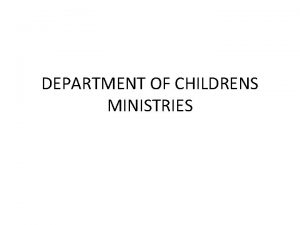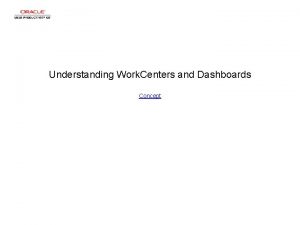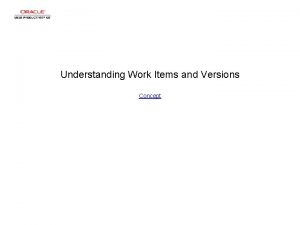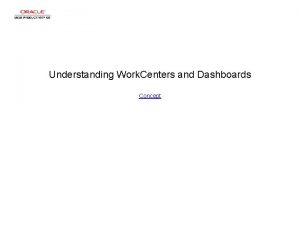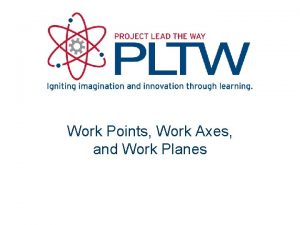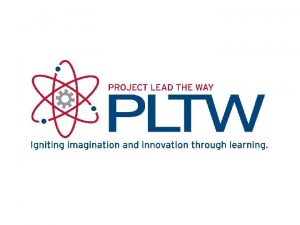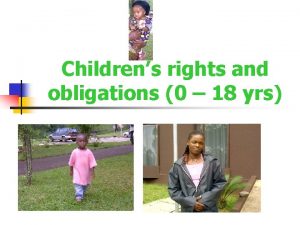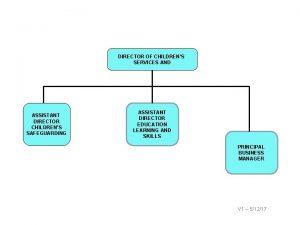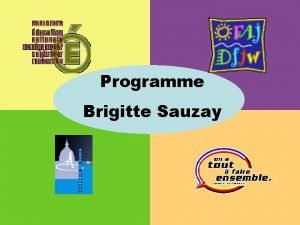The Understanding Childrens Work UCW programme and ICID

































- Slides: 33

The Understanding Children’s Work (UCW) programme and ICID Database Opportunity for research Summer School in Development Economics Prato June 22, 2017

ICID-Programme background The Italian Centre for International Development (ICID) – hosted by CEISUniversity of Rome ‘Tor Vergata’ – aims at promoting a better understanding of current and prospective global development challenges through an interdisciplinary approach. To this end, the mandate of ICID has been designed along the following 3 core pillars: • Promoting and implementing high-level and policy-relevant research across the wide spectrum of development areas. • Building and facilitating an inter-disciplinary network of experts in the development arena, connecting academia and researchers as well as practitioners in the development field, with a view to increasing the impact of the research community on policy making and development cooperation.

ICID-Programme background • Creating training opportunities for young researchers in the development field, through Ph. D and Master courses, seminar and workshop series, student exchanges (involving institutions from both industrialized and lessindustrialized countries), as well as research mentoring. ICID’s design and composition provides it with a unique capacity for state-ofthe-art research addressing the many interconnected development issues facing today’s globalized world. The ownership and reach of ICID research is strengthened further through active research partnerships with government counterparts, workers’ and employers’ organizations, international development organizations, private financial institutions, private sector firms, as well as regional and international development banks. Website: http: //www. icid. info

UCW-Programme background • Launched in December 2000 • Inter-agency research cooperation initiative involving ILO, UNICEF and World Bank • Forms part of the Research and Evaluation Unit of the ILO FUNDAMENTALS Branch • Financed by contributions from donor countries and by core agency resources • Located at the ILO Office for Italy in Rome • Guided by the recommendations of the Roadmap adopted at The Hague Global Child Labour Conference 2010 and the Sustainable Development Goals • Mandate now extends to research addressing other fundamental principles and rights at work violations (i. e. forced labour, discrimination, freedom of association)

UCW-Programme background The Roadmap highlights the urgent need to upscale and accelerate country level actions against child labour in order to succeed in global child labour elimination goals. Policy priorities identified in the Roadmap include adopting and enforcing legislation on child labour, developing and implementing national action plans, providing adequate resources to achieve policy goals, and supporting decent and productive work for adults and youth of working age. In addition, the Roadmap underscores the importance of improved child labour statistics and knowledge to inform policy action.

UCW-Programme background In close partnership with leading academics and decisionmakers – policymakers, practitioners, and donors working with child laboures and vulnerable youth around the world – UCW produces research aimed at informing policies in the area of child labour and youth employment. Research covers child labour and youth employment challenges in their various dimensions – their nature, extent, causes and consequences – as well as which policies approaches are most effective in addressing them. Website: www. ucw-project. org

Core programme components

1. STATISTICS AND MEASUREMENT

1. STATISTICS AND MEASUREMENT The Statistics and measurement component is aimed at improving the technical tools used to measure, monitor and analyse child labour and youth employment issues. The database provides a wide array of indicators on child labour, schooling and related topics, organised by country, reference year and topic. The indicators are also decomposed by sex, residence and age range. The statistics for each indicator are based on a variety of nationally-representative household surveys.

1. STATISTICS AND MEASUREMENT Develop a system for monitoring SDG 8. 7 and youth employment • New interactive child labour indicators database, expansion to include adolescent hazardous work, child labour trends, forced labour indicators • Development and harmonisation of indicators and support to ICLS process (e. g. , household chores, forced labour) • Dissemination of CL statistics (e. g. , USDOL TDA Report, World Bank Development Indicator (WDI) http: //www. ucw-project. org/statistics-child-labour. aspx

1. STATISTICS AND MEASUREMENT Child labour indicators – broad categories CHILD LABOUR HAZARDOUS WORK CHILD LABOUR INCLUDING HOUSEHOLD CHORES CHILD LABOUR BY SECTOR IN EMPLOYMENT CHILD LABOUR BY STATUS IN EMPLOYMENT ECONOMIC ACTIVITY SCHOOL ATTENDANCE CHILDREN'S ACTIVITY STATUS CHILD POPULATION ECONOMIC ACTIVITY BY WEALTH QUINTILE SCHOOL ATTENDANCE BY WEALTH QUINTILE ECONOMIC ACTIVITY BY SECTOR IN EMPLOYMENT ECONOMIC ACTIVITY BY STATUS IN EMPLOYMENT WORKING HOURS HOUSEHOLD CHORES WEEKLY HOURS IN HOUSEHOLD CHORES CHILD LABOUR AS PERCENTAGE OF CHILDREN IN ECONOMIC ACTIVITY

1. STATISTICS AND MEASUREMENT Example of available indicators CHILD LABOUR Available indicators Child labour, 5 -14 yr olds, total Child labour, 5 -14 yr olds, male Child labour, 5 -14 yr olds, female Child labour, 5 -14 yr olds, urban Child labour, 5 -14 yr olds, rural Child labour, 5 -17 yr olds, total Child labour, 5 -17 yr olds, male Child labour, 5 -17 yr olds, female Child labour, 5 -17 yr olds, urban Child labour, 5 -17 yr olds, rural Hazardous work, 15 -17 yr olds, total Hazardous work, 15 -17 yr olds, male Hazardous work, 15 -17 yr olds, female Hazardous work, 15 -17 yr olds, urban Hazardous work, 15 -17 yr olds, rural

1. STATISTICS AND MEASUREMENT

1. STATISTICS AND MEASUREMENT Youth employment indicators – broad categories

1. STATISTICS AND MEASUREMENT: source of data � ILO SIMPOC surveys (Monitoring Programme on Child Labour) (http: //www. ilo. org/ipec/Childlabourstatistics. SIMPOC/Questio nnairessurveysandreports/lang--en/index. htm) �World Bank multi-purpose household surveys (Living Standards Measurement Study - Integrated Surveys on Agriculture - LSMS-ISA) (http: //go. worldbank. org/BCLXW 38 HY 0) World bank survey data catalogue (http: //microdata. worldbank. org/index. php/catalog/lsms)

1. STATISTICS AND MEASUREMENT: source of data �UNICEF MICS (Multiple Indicator Cluster Surveys ) surveys (http: //mics. unicef. org/); • Demographic and Health surveys - DHS program (http: //dhsprogram. com/) �and National Labour Force surveys; are among the most important instruments for generating information on child labour and youth employment issue in developing countries.

2. POLICY-ORIENTED RESEARCH

The approach 2. POLICY-ORIENTED RESEARCH

2. POLICY-ORIENTED RESEARCH Example: research papers

CHILD LABOUR BIBLIOGRAPHY The bibliography provides a comprehensive listing of published research relating to child labour, organised by author, topic and year

3. IMPACT EVALUATION

3. IMPACT EVALUATION The Impact evaluation component forms part of a broader effort to improve understanding of the relative effectiveness of different programmatic approaches for addressing child labour and youth employment challenges. It focuses on building and spreading knowledge on the impact of specific programme interventions on child labour and youth employment and on ways to measure such impact.

The approach 3. IMPACT EVALUATION – the approach

3. IMPACT EVALUATION Improving the design of cash transfer programs to address child labour • Cash transfer scheme in the Philippines (4 Ps), Lesotho (CGP) and Mexico (Prospera) Filling the knowledge gap on the child labour impact of other interventions • Remedial education (Speed School Programme, Mali); • Public works (Malawi Social Action Fund); • Women’s empowerment (RIB, Nicaragua) Evaluation of child labour targeted programs • Impact evaluation of IPEC project in El Salvador. Spreading knowledge on child labour impact • Inventory of impact evaluations • Review of impact evaluations of policy interventions relating to child labour

3. IMPACT EVALUATION The results of these evaluations are posted on the web-based impact evaluation studies

3. IMPACT EVALUATION: inventory

3. IMPACT EVALUATION: inventory Example: completed impact evaluations of projects in the social protection sector

4. COUNTRY LEVEL STUDIES

4. COUNTRY LEVEL STUDIES The Country Report series provides overviews of child labour, youth employment and related issues in specific national contexts. The reports help in creating a common knowledge base on these issues and in informing policy responses to them. They are the product of a collaborative effort involving Government, local stakeholders and researchers, the three UCW partner agencies and the UCW Secretariat. Thematic background research papers by national counterparts feed into the development of the Country Reports.

4. COUNTRY LEVEL STUDIES Implementation mechanisms

4. COUNTRY LEVEL STUDIES The Country report are posted on the web -based COUNTRY REPORTS

5. UNIVERSITY COLLABORATION

5. UNIVERSITY COLLABORATION Collaboration with universities and research institutes is aimed at promoting and building the local capacity to undertake child labour research; It is contributing in a substantial way towards creating a community of researchers working on child labour, youth employment and related issues in countries where eliminating child labour and ensuring decent work for youth remain priority challenges
 University canada west dli number
University canada west dli number 23 april international children's day turkey
23 april international children's day turkey Texas childrens moli
Texas childrens moli The christian childrens fund
The christian childrens fund Childrens services
Childrens services Walsall childrens services
Walsall childrens services Levine childrens
Levine childrens Multi agency assessment
Multi agency assessment Traditional literature quiz
Traditional literature quiz The childrens university of manchester
The childrens university of manchester Longman children's picture dictionary
Longman children's picture dictionary Black childrens memorial
Black childrens memorial Fever in toddlers when to worry
Fever in toddlers when to worry History of childrens literature
History of childrens literature Colorado children's book award
Colorado children's book award Understanding groups and teams
Understanding groups and teams Work programme
Work programme Seetec work programme
Seetec work programme Understanding work teams
Understanding work teams Teams typically outperform individuals
Teams typically outperform individuals Why have teams become so popular
Why have teams become so popular Understanding work teams
Understanding work teams Chapter 4 work and energy section 1 work and machines
Chapter 4 work and energy section 1 work and machines Hát kết hợp bộ gõ cơ thể
Hát kết hợp bộ gõ cơ thể Slidetodoc
Slidetodoc Bổ thể
Bổ thể Tỉ lệ cơ thể trẻ em
Tỉ lệ cơ thể trẻ em Gấu đi như thế nào
Gấu đi như thế nào Thang điểm glasgow
Thang điểm glasgow Hát lên người ơi alleluia
Hát lên người ơi alleluia Môn thể thao bắt đầu bằng chữ f
Môn thể thao bắt đầu bằng chữ f Thế nào là hệ số cao nhất
Thế nào là hệ số cao nhất Các châu lục và đại dương trên thế giới
Các châu lục và đại dương trên thế giới Công thức tính thế năng
Công thức tính thế năng


